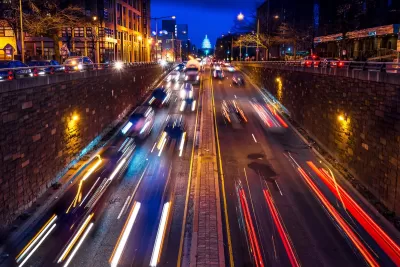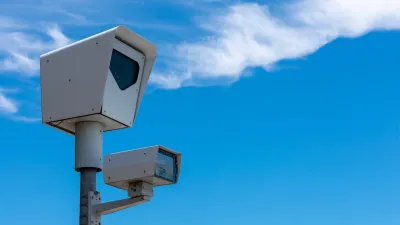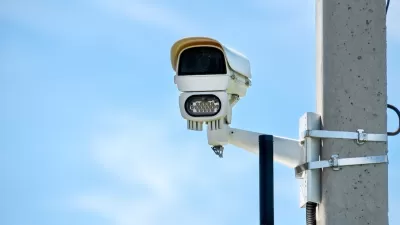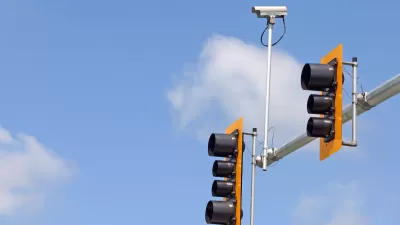Automated enforcement is reducing speeding, but bigger changes to street design and the built environment are needed to make the District’s streets safer and more pleasant for people walking.

In a deep dive in Greater Greater Washington, Pete Rodrigue describes how the Washington, D.C. District Department of Transportation is using automated traffic enforcement to improve road safety and reduce interactions with police. The District recently doubled the number of cameras on the streets in the last year, leading to a large increase in tickets issued between 2022 and 2024, with the District issuing over 250,000 tickets in May 2024.
Rodrigue includes data about how many tickets actually get paid, noting that ticket revenue fell sharply during the Covid-19 pandemic and has not returned to pre-pandemic levels. “This appears to be due to the fact that each camera has been resulting in less revenue because of drivers’ nonpayment,” Rodrigue adds.
As to the question of whether cameras are effective, data shows that cameras tend to issue fewer tickets over time, signaling that drivers who get used to seeing them are less likely to speed. Notably, “studies find that cameras reduce total crashes by roughly 20%, at least in the area around the camera. Traffic cameras may also lower pedestrian injuries, although fewer studies estimate this directly, and some research has found mixed results.”
Rodrigue also highlights the ways that cameras can’t fix our broken built environment: while they might discourage drivers from speeding, they don’t make roads with poor pedestrian infrastructure safer or more pleasant to walk on. And while cars might be moving more slowly, they can still injure or kill pedestrians, even when driving the speed limit. “There’s actually some evidence that the people who speed a little bit on badly designed roads may cause more pedestrian deaths than the small number of people who drive significantly over the limit.”
Ultimately, automated enforcement can still perpetuate inequities baked into our transportation planning. They are just one tool of many needed to improve U.S. road design to limit pedestrian injuries and deaths and make roads safer for everyone who uses them. As Rodrigue points out, “cameras alone will not refashion badly designed stroads into more humane, livable streets. They will not prevent the many crashes that occur within posted speed limits. And without a thoughtful approach, which the District has yet to develop, automated traffic enforcement risks punishing Black and low-income drivers for the sins of traffic engineers.”
FULL STORY: Smile, you’re on camera: A deep dive on automated traffic enforcement data

Manufactured Crisis: Losing the Nation’s Largest Source of Unsubsidized Affordable Housing
Manufactured housing communities have long been an affordable housing option for millions of people living in the U.S., but that affordability is disappearing rapidly. How did we get here?

Americans May Be Stuck — But Why?
Americans are moving a lot less than they once did, and that is a problem. While Yoni Applebaum, in his highly-publicized article Stuck, gets the reasons badly wrong, it's still important to ask: why are we moving so much less than before?

Using Old Oil and Gas Wells for Green Energy Storage
Penn State researchers have found that repurposing abandoned oil and gas wells for geothermal-assisted compressed-air energy storage can boost efficiency, reduce environmental risks, and support clean energy and job transitions.

Updating LA’s Tree Rules Could Bring More Shade to Underserved Neighborhoods
A new USC study finds that relaxing Los Angeles’ outdated tree planting guidelines could significantly expand urban tree canopy and reduce shade disparities in lower-income neighborhoods, though infrastructure investments are also needed.

California's Canal Solar Projects Aim to Conserve Resources and Expand Clean Energy
California’s Project Nexus has begun generating electricity from solar panels installed over irrigation canals, with researchers and state agencies exploring statewide expansion to conserve water and boost clean energy production.

HHS Staff Cuts Gut Energy Assistance Program
The full staff of a federal program that distributes heating and cooling assistance for low-income families was laid off, jeopardizing the program’s operations.
Urban Design for Planners 1: Software Tools
This six-course series explores essential urban design concepts using open source software and equips planners with the tools they need to participate fully in the urban design process.
Planning for Universal Design
Learn the tools for implementing Universal Design in planning regulations.
Heyer Gruel & Associates PA
City of Moreno Valley
Institute for Housing and Urban Development Studies (IHS)
City of Grandview
Harvard GSD Executive Education
Salt Lake City
NYU Wagner Graduate School of Public Service
City of Cambridge, Maryland





























